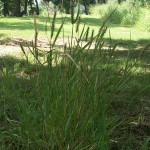Virginia Wildrye
Elymus virginicus
Poaceae
Description
Special Note: Frank Gould in The Grasses of Texas states E. virginicus hybridizes with E. canadensis and other Elymus species. This table should help distinguish the two species where minimal hybridization has occurred:| CHARACTERISTIC | Elymus canadensis | Elymus virginicus |
| Seedhead | Nodding seedhead, especially by maturity | Stiffly erect seedhead |
| Glumes | Sharp “V” shaped | Bowed out “U” shaped |
| Awns | Long and divergent | Straight and short |
Habitat
Grows on shaded banks, fence rows, and open woodlands. It prefers sites with higher moisture but tolerates drier habitats than E. canadensis.Images
Plant Characteristics
Seed Type: Non-Encapsulated
Duration: Perennial
Stem Texture: Hairless/Smooth
Growth Habit: Bunch grass, Grasses
Season: Cool
Distribution
 : 01 - Pineywoods, 02 - Gulf Prairies and Marshes, 03 - Post Oak Savannah, 04 - Blackland Prairies, 05 - Cross Timbers and Prairies, 06 - South Texas Plains, 07 - Edwards Plateau, 08 - Rolling Plains
: 01 - Pineywoods, 02 - Gulf Prairies and Marshes, 03 - Post Oak Savannah, 04 - Blackland Prairies, 05 - Cross Timbers and Prairies, 06 - South Texas Plains, 07 - Edwards Plateau, 08 - Rolling Plains
Distributions
Distribution refers to the ecological region in Texas that a plant has been found. You can also view a clickable map.
Book: Know Your Grasses (B-182)
Collection: Grasses



